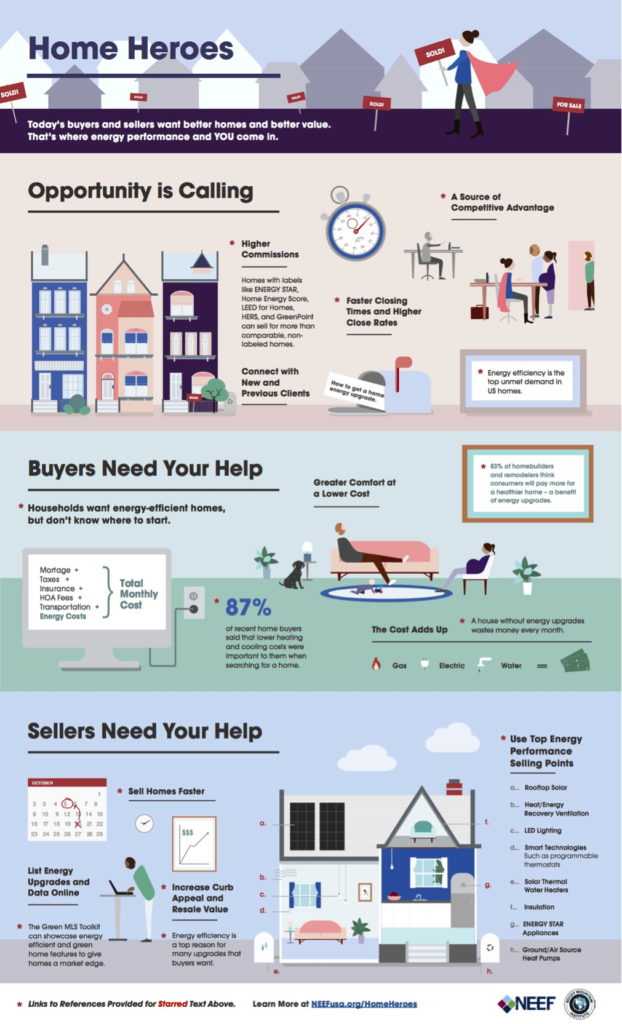
Sold! Why Understanding Home Energy Performance Will Become a Key to Real Estate Success
Real estate professionals play a pivotal role in the U.S. residential real estate market. Overseeing from start to finish the multiple steps and piles of paperwork involved with property transactions, they support both sellers moving forward with the next stage of their lives and buyers looking for a new place to call home. They provide trusted and influential guidance that affects the largest investment that most of us will ever make: our homes.
Home energy performance is too often overlooked by buyers and sellers during property transactions, and buyers seldom have easy access to energy performance information. Even though U.S. homeowners spend on average about $2,200 per year on energy bills and increasingly indicate demand for energy-efficient homes, real estate professionals generally undersell (or are unaware of) the benefits of homes with strong energy performance. These benefits include improved comfort, health, privacy, programmability, and interconnectivity, as well as increased monthly affordability and—where relevant information is made available—resale value. Moreover, U.S. real estate listings generally lack details about a property’s energy performance, energy-efficient features, and estimated utility costs. This omission contributes to the unnecessary perpetuation of the invisibility of home energy upgrade investments, housing dissatisfaction, underinvestment in home energy upgrades, plateauing residential energy savings, and risks to U.S. real estate market stability.
Opportunity is calling for all real estate professionals to tap the promising U.S home energy upgrades market by helping clients understand, prioritize, and invest in home energy performance during the property transaction process—when buyers and sellers already tend to make general home improvements. Real estate professionals who enhance their home energy performance capabilities can lead their competitors on market trends and improve the long-term prospects of their business.
CHANGING CONSUMER DEMANDS
Real estate professionals are under pressure to accommodate various evolving market trends. Consumer preferences are diverging based on generation, with baby boomers looking to age in place and millennials becoming the largest share of home buyers with their own demands. Numerous residential energy technologies—including rooftop solar, LED lighting, programmable thermostats and appliances, heat pumps, and battery storage—are becoming commonplace and sought-after in homes. State and local governments are also increasing standards for energy performance for new and existing homes. For example, California has a statewide goal for all new residential construction to achieve zero net energy status by 2020.
Real estate professionals can embrace and profit from these market trends by making home energy performance a core component of the support they provide for buyers and sellers. Those who help clients identify where to start, which home energy upgrades can deliver the most value, and how to showcase these upgrades during property sales will be better situated to meet emerging consumer demands and ride the wave of market trends for profit. As such, real estate professionals who ignore insights about where the market is heading and fail to build their own energy performance capabilities should expect to fall behind.
USING HOME ENERGY PERFORMANCE TO GET AHEAD
In the rapidly evolving U.S. residential market, real estate professionals can leverage home energy performance to achieve faster closing times and higher closing rates, larger commissions, and greater competitive advantage.
To encourage and empower U.S. real estate professionals to understand and promote the multiple benefits of homes with strong energy performance, RMI’s Residential Energy+ team developed the “Home Heroes” infographic in partnership with the National Environmental Education Foundation (NEEF)—a congressionally chartered organization with a vision to have 300 million Americans actively use environmental knowledge by 2022.
This shareable education tool describes how real estate professionals can support home buyers and sellers in the pursuit of homes that are better for their families, their pocketbooks, and the environment in order to gain competitive advantage in a real estate market that’s evolving to meet changing customer demands. More specifically, the tool links to leading research about the ways that real estate professionals can gain from making energy performance central to the support they provide buyers and sellers, along with specific actions they can take to better support their clients.
GAINING A GREEN CREDENTIALS ADVANTAGE
Real estate professionals with green credentials—namely, the National Association of REALTORS® Green Designation—maintain a higher standard of support for buyers and sellers. They understand why energy performance matters. They also know how to implement green data entry fields on multiple listing service (MLS) systems, promote the benefits of energy-efficient features, get enhanced property valuations from appraisers with sustainability credentials, and use energy performance to differentiate among properties.
Until home energy performance capabilities become a general industry standard for real estate professionals, green credentials like the REALTORS® Green Designation offer a useful indicator for buyers and sellers seeking higher quality support and better outcomes during real estate transactions. Buyers and sellers who want homes delivering greater comfort, health, resale value, and affordability for their families should therefore seek out real estate professionals with such credentials.
As more buyers and sellers seek the benefits that high-performance homes deliver and expect assistance finding them during the property transaction process, real estate professionals who embrace market trends and take the initiative today to make home energy performance central to their client support will be in an advantageous position to harness the markets of tomorrow.
Download RMI and NEEF’s “Home Heroes” infographic via www.NEEFusa.org/HomeHeroes, and share it with real estate professionals in your networks to help them leverage home energy performance to better capture and profit from market trends.

